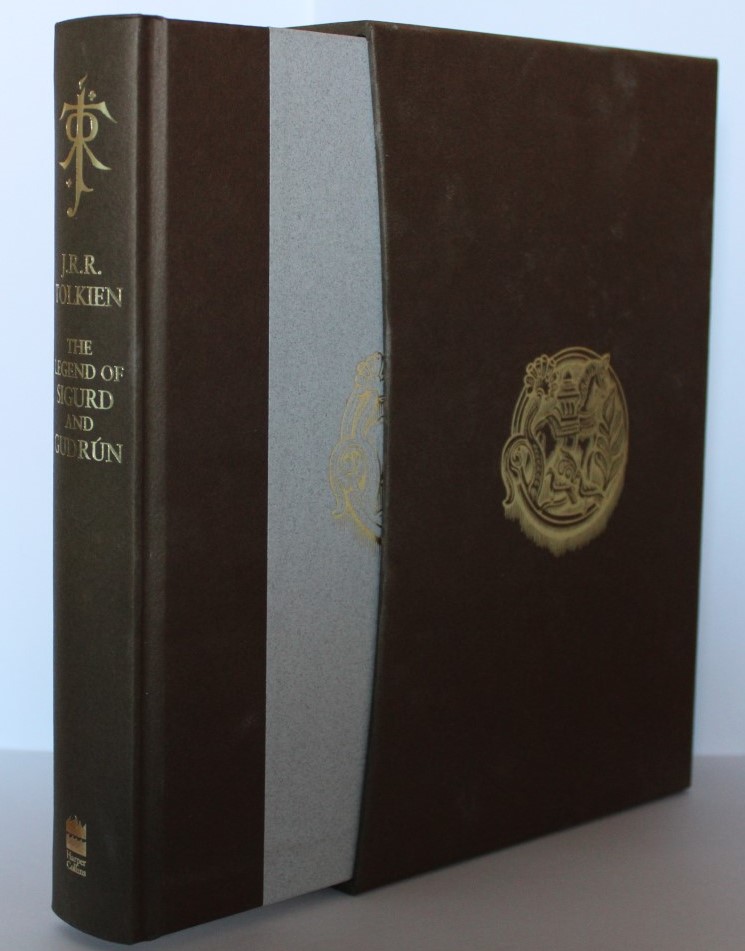Caring For Your Tolkien Collection
Copyright 1998 Christina Scull & Wayne G. Hammond, all rights reserved
Many thanks to Christina and Wayne for permission to reprint this article from The Tolkien Collector #18, June 1998.
Now that you've bought that expensive proof copy of The Lord of the Rings, or that rare first edition Hobbit inscribed by the author, or that original Tolkien manuscript - or even that old Ballantine reprint for a few pennies - what should you do to keep your treasure well cared-for? Other collectors have asked us what we do, and we have long promised to reply in these pages. In doing so, however, we want to make it clear that our methods are not the only possible methods, our standards not the only standards, our philosophy of collecting by no means the one, true philosophy of collecting. What you will do will depend upon a variety of factors, especially how much storage space you have, and how much money you can afford to spend on conservation (though many good conservation practices are cost-free).
Shelves and uprights should be smooth, with no protruding nails or rough places which could scratch the books. Most of our books are in very sturdy but inexpensive open six-by-three-by-one-foot bookcases with oak veneer over compressed wood. Glass fronts to bookcases look nice, but really do not keep books dust-free. Bookcases indeed should not be dust-tight, else each case would have its own microclimate, and tend to excessive dryness or dampness. Allowing air to circulate around books (don't push them tight against the back of the bookcase or up against the wall) helps to prevent the growth of harmful mould or mildew.
Don't store books on shelves so tightly against one another that you have to force a book out when you want it. Don't pull on the top of the spine (it's a good way to tear the headcap); do grasp the book on either side of the spine. Books should be vertical or lying flat: allowing a book to lean at an angle may weaken the binding. Try not to put books side by side which are too disparate in size, as the larger book may then lean. Use bookends to keep books vertical when a shelf is not full, but check that there are no rough edges on the bookends to cause damage.
Reluctant housekeepers will be pleased to know that books should not be dusted too often, as the more they are handled, the more chance there is of damage. Here in rural Massachusetts, where we have relatively little air pollution, once every six to twelve months would be ideal, but in practice we might dust our books once every two or three years, and with some 12,000 volumes in the house, obviously not all at once! Most of our books do not have much space between their tops and the bottom of the shelf above, so that dusting books almost always means removing them from their shelves. We use one of those ingenious sticks with lambswool or other material wrapped around most of the length, which attracts dust electrostatically and can be used to very gently clean the tops of books and exposed parts of shelves. A vacuum cleaner with a soft brush attachment is useful, except around bindings that might have loose pieces; but this will not pick up stubborn, clinging dust. A Chinese brush - long, soft hair set in joined bamboo stems - from a conservation supplies dealer is a good alternative, as it is naturally gentle, though it tends to move dust around rather than pick it up. We have also followed the advice of Carolyn Horton's Cleaning and Preserving Bindings and Related Materials (American Library Association, 1969), who recommends using one hand to hold each book tightly closed at the fore-edge and tilted forward, and with the other hand gently brush any dust off the top of the book with a treated dustcloth - either a 'One-Wipe' commercial cloth (available in supermarkets etc.) or some similar product, or with a clean rag treated with Endust or a similar dust-attracting spray.
Light is radiant energy, which breaks or weakens the molecular bonds in paper, cloth, etc., causing brittleness, browning, and fading. This happens over a period of time, so that the collector may not notice any degradation until it is too late. Therefore we tend to keep our curtains or shades drawn when we are not in the room, or if the sun is shining in too brightly. Eventually we hope to have florescent lights only in utility areas, away from books, for these, light sunlight, have a harmful ultraviolet component. Incandescent lights are relatively safe, as are shielded halogen lamps, such as we have in our Tolkien Library.
Books, posters, art - indeed, anything a Tolkien collector might have - will benefit from a controlled climate, or at least a climate in which extremes of or sudden changes in temperature and humidity are avoided. Gradual changes in these factors allow books etc. time to become acclimatized. We do not have air-conditioning in our house, only central heating, but the Williamstown, climate is generally favourable for books as well as people. For many years the ideal climate for books had been said to be around 65 degrees Fahrenheit with 50 percent relative humidity but conservation experts now claim that books can tolerate a greater climatic range, with humidity as low as 25 percent. For the private collector this advice usually boils down to: don't keep your collection in a damp basement or a hot attic.
The dust-jacket is the most fragile part of a typical hardcover book, and benefits from protection. Archival jacket covers - sleeves made with an inert clear plastic and acid-free paper backing - are available in various heights. These prevent rubbing, scratching, and tearing, and of course help to keep jackets clean. A jacket which has already been torn is even more in need of sleeving, which will prevent any further damage and keep loose pieces in place pending repairs. For economy we buy covers on rolls, and cut off lengths as needed; but pre-cut covers are also available.
Paperbacks may also be covered, with inert plastic and archival tape (which is attached only to the plastic, not to the book itself). Christina covered her paperbacks when she lived in London; Wayne never covered his. We no longer bother to cover most paperbacks, but rely on careful handling.
Pamphlets and very thin books need special care. We place our most valuable and vulnerable items, such as A Middle English Vocabulary, in pamphlet binders made of acid-free stiff board with a cloth spine, enclosing an inner folder of acid-free paper. A cheaper though less protective measure would be to place the items in acid-free photo storage envelopes with gumless flaps; we do this for less valuable items, such as the Tolkien Society's Peter Roe booklets. The drawback with envelopes is that one must be careful not to slice the enclosure on an edge of the envelope when inserting it.
We store our smaller Tolkien-related magazines upright in archival pamphlet boxes, and our larger magazines, calendars, artwork, and smaller posters flat in clamshell storage boxes of various sizes. We keep our larger posters in archival map cases under the bed. The latter means that we have to take care lifting posters out when we want to find one, but they are flat so one does not have to hold the corners down. Ideally we should have each item in an acid-free folder, but large map and print folders are expensive. We find the use of map cases more efficient than storing posters in tubes, but if you wish to take the latter approach, be sure to buy archival tubes with ends that unscrew or have other easy means of getting at the contents so that you don't have to twist the poster round and pull when you want to get it out.
We find, on reading current supply catalogues, that the big map cases we use are apparently no longer available, though newspaper or print boxes are, and these would accommodate smaller posters etc. Libraries tend to use metal or wood architect's plan file cabinets to store large flat items.
Ideally each item in a collection should be separately housed, in a box or folder or envelope, to prevent the 'migration' of acid from one piece to another of the spread of mould. Many papers have some acidic component, or form acids over time. Anything which is particularly likely to decay, such as newsprint, or which might have mould, should not be allowed to come in contact with other items. We have enclosed such items in Melinex (Mylar), a transparent conservation plastic, which we buy in rolls.
When making any minor repairs to paper we use only acid-free document repair tape or tissue to mend tears, and Pink Pearl or soft white erasers (never what one finds on pencil ends) to gently erase light marks. The amateur should leave major repairs to a professional conservator or bookbinder.
Suppliers
This is not an exhaustive list by any means. We have used all of the U.S. suppliers at one time or another, and some of the U.K. suppliers. [Jeremy's note - I've removed email addresses from the original list to prevent spam propagation.]
Bill Cole Enterprises, P.O. Box 60, Dept. AR, Randolph, MA 02368; tel. 617-986 2653. Our source for Mylar.
Gaylord, P.O. Box 4901, Syracuse, NY 13221; customer service tel. 800-634 6307, http://www.gaylord.com
The Hollinger Corp., P.O. Box 8360, Fredericksburg, VA 22404; tel. 800-634 0491 or 703-898 7300.
Light Impressions, P.O. Box 940, Rochester, NY 14603; tel. 800-828 6216 or 716-271 8960.
University Products, 517 Main St., Holyoke, MA 01041; customer service tel. 800-628 1912 or 413-532 3372; http://www.universityproducts.com. This is our primary source for dust-jacket covers and much else.
Atlantis European Ltd, 146 Brick Lane, London E1 6RU, U.K.; tel. 0171-377 8855.
Conservation by Design, Timecare Works, 60 Park Rd. West, Bedford MK41 7SL, U.K.; tel. 01234-217258; http://www.conservation-by-design.co.uk.
Conservation Resources, Units 1, 2 & 4 Pony Rd., Horspath Industrial Estate, Cowley, Oxfordshire OX4 2RD, U.K.; tel. 01865-747755.
Don Gresswell Ltd, Bridge House, Vera Ave., Grange Park, London N21 1RB, U.K.; tel 0181-370 7000.





 8
8 1739
1739